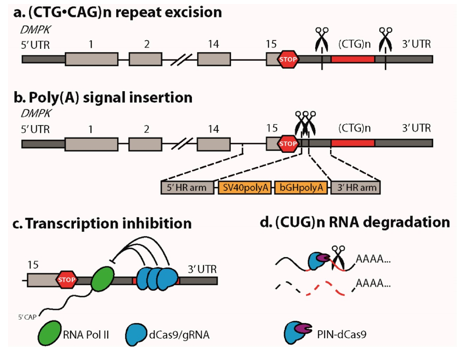
Our promise to you:
Guaranteed product quality, expert customer support.
 24x7 CUSTOMER SERVICE
24x7 CUSTOMER SERVICE
 CONTACT US TO ORDER
CONTACT US TO ORDER
CRISPR/Cas9 Technology on Myotonic Dystrophy Research 
Myotonic dystrophy (DM) is an autosomal neuromuscular disease that contains two distinct forms, myotonic dystrophy type 1 (DM1) and type 2 (DM2), which are due to abnormal microsatellite expansions of CTG repeats in the 3’UTR of the DMPK gene and CCTG repeats in the first intron of ZNF9 gene, respectively. Both are involved not only in myotonia and progressive muscle weakness, but also in wide clinical features including heart conductions defects and central nervous system (CNS) alterations. Mutant RNAs carrying expanded repeats are preserved in the nucleus as discrete foci and expanded C(C)UG repeats abnormally interact with MBNL RNA-binding proteins. Sequestration of MBNL factors hampers its normal function in the regulation of alternative splicing events, hence some splicing changes in DM patients have been associated with clinical symptoms such as insulin resistance, muscle weakness, myotonia, cardiac and cognitive defects.
The CRISPR/Cas9 System in Myotonic Dystrophy
DM1 is caused by expanded CTG repeats in the 3’UTR. It is possible that simply deleting the expanded CTG repeats may cure the disease. With the progress of therapeutic genome-editing technologies, this is becoming more realistic. Genome editing using CRISPR/Cas9 represents a powerful method for the correction of various disease mutations. This strategy is highly suitable for treating DM1, since the removal of the CTG repeat tract or insertion of regulatory sequence in the DMPK gene will abolish the transcription of the pathogenic CTG. Thus, all of the downstream pathogenic events associated with DM1 would be rectified. Researchers have recently explored the use of CRISPR/Cas9 to completely excise the expanded trinucleotide CTG repeats in the DMPK gene to generate DM1-corrected myogenic cells derived from DM1 patient-specific iPS cells. Relatively robust phenotypic correction was observed after gene editing in the CRISPR/Cas9-corrected DM1-HIDEMs, consistent with the disappearance of ribonuclear foci, one of the hallmarks of DM1. This paralleled the reversion of the abnormal splicing patterns in DM1. Similarly, Wieringa et al. have shown that CRISPR/Cas9 enabled complete and precise removal of the CTGexp alleles in myoblasts from DM1 mice and patients. This led to normalization of the myogenic capacity, nucleocytoplasmic distribution, and abnormal RNP-binding behavior of transcripts from the edited DMPK gene.
 Figure 1. CRISPR/Cas9 strategies successfully applied in DM1 models. (Raaijmakers R H L, et al. 2019)
Figure 1. CRISPR/Cas9 strategies successfully applied in DM1 models. (Raaijmakers R H L, et al. 2019)
Therapeutic Outlook for CRISPR/Cas9 Approaches in DM1
- Ex Vivo Cell Therapy
A meaningful therapeutic intervention in DM1 demands gene editing of a large part of the (stem) cell pool to halt disease progression and significantly contribute to improvement in the long term. Thus, an ex vivo approach, namely cell therapy based on autologous CRISPR/Cas9-edited cells from DM1 patients, might be considered. Two laboratories have used DM1 iPSCs both aimed to end up with genetically edited iPSCs, which can be differentiated into suitable muscle or neuronal progenitor cells creating an unlimited amount of autologous, non-immunogenic healthy cells. Repeat-corrected cells will hopefully prove to be useful to halt or delay the degenerative process in DM1 patients in the future.
- In Vivo Gene Editing
In patients, non-viral vector methods seem only applicable for site-specific, local delivery into skeletal muscle. Considering the multisystemic manifestation of DM1, therapeutic approaches call for systemic delivery by AAV vectors. Recently, the number of clinical trials in which AAVs have been used for in vivo gene therapy has continuously increased. It still remains challenging to achieve the expression of an effective CRISPR/Cas9 system at therapeutic levels. Especially for DM1, as a multisystemic disorder, many organs must be targeted for a clinical benefit in the patient, such as heart, skeletal muscle, gastrointestinal tract and brain. Modification of capsid proteins and incorporation of targeting peptides on the surface of AAV capsids may specify transduction of specific cell types. More specific delivery might be an enormous undertaking, but brings benefits, e.g., decreased vector production and decreased vector exposure.
Our CRISPR/Cas9 System Services
CRISPR/Cas9 PlatformCB, a global leading genetic editing biotechnology company, is committed to providing the most professional and comprehensive genetic editing technology solutions for our clients. To support your projects, we offer a comprehensive custom CRISPR/Cas9 gene editing service from strategy design to final DM model generation.
➢ Human Cell Models Generation of DM by CRISPR/Cas9 System
➢ Animal Models Generation of DM by CRISPR/Cas9 System
If you have any questions, please feel free to contact us.
Related Services and Products
Animal Models
- Conditional Knockout Mouse
- Conventional Knockout Mouse
- Point Mutation Mouse
- CRISPR/Cas9 Knockin Mouse
- Rosa26 Knockin Mouse
Cell Lines
- Point Mutation Cell Line Generation
- HIEF™ Site-Specific Knock-in Cell Line Service
- Fragment Deleted Stable Cell Line
- Gene Editing in Primary T Cells
- Gene Knockout Cell Line Generation
Products
- CRISPR/Cas9 Kits
- Pre-made Knockout Cell Line
- CRISPR Lentiviral Library
- Cas9 Related Plasmids
- Pre-made Cas9 Virus Particles
References
- Raaijmakers R H L, et al. CRISPR/Cas Applications in Myotonic Dystrophy: Expanding Opportunities. International journal of molecular sciences, 2019, 20(15): 3689.
- Chuah M, et al. Gene Therapy and Gene Editing for Myotonic Dystrophy. Muscle Gene Therapy. Springer, Cham, 2019: 525-548.
- Gourdon G, Meola G. Myotonic dystrophies: state of the art of new therapeutic developments for the CNS. Frontiers in cellular neuroscience, 2017, 11: 101.
- Wang Y, et al. Therapeutic genome editing for myotonic dystrophy type 1 using CRISPR/Cas9. Molecular Therapy, 2018, 26(11): 2617-2630.